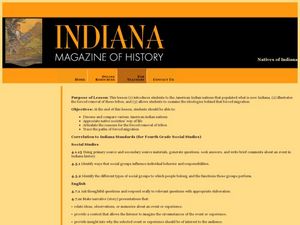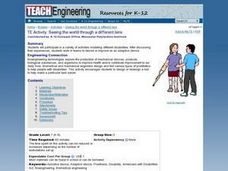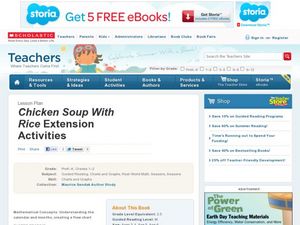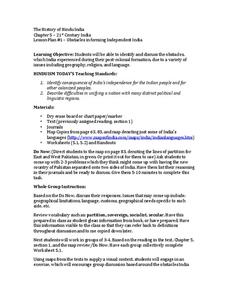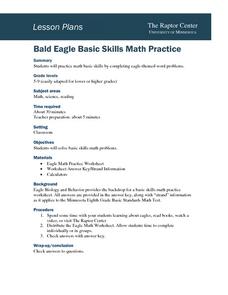Curated OER
Lesson Plan on Family History and Past Generations
Second graders listen to The Keeping Quilt and through class/small group discussion relate this story to beliefs, customs, and traditions of their own families. They make a class quilt based on these discussions.
Curated OER
The Call of the Wild
Students read The Call of the Wild, noting its theme of survival. They investigate the book's concepts with word webs, spider maps, or graphic organizers. They conduct a panel discussion on dogs and wolves. They write a letter to the...
Curated OER
Natives of Indiana
Fourth graders participate in discussions about the Native Peoples who inhabited what is now Indiana. In this Native American lesson, 4th graders discuss the social and cultural structures of these Native Americans. They locate the...
Curated OER
Chances Are-Part 1
Students are introduced to the idea of probability by discussing the likelihood of events occurring. Pupils describe events that are certain, impossible, likely, and unlikely to occur. They determine the likelihood of an event occurring...
Curated OER
What a Cosmic Web We Weave
Students explore, using journals and discussion in small groups, how the universe has evolved since the theoretical Big Bang and create dramatizations of various eras in cosmic evolution.
Curated OER
Technology: Biomedical Engineering
Learners participate in activities simulating various disabilities. After discussions, they work in teams to devise or improve on adaptive devices for people with disabilities. They include drawings of the tools they design and explain...
Curated OER
Let's Sleep on It
Learners research sleep following a class discussion on an article in The New York Times. Students use their research information to create a health and wellness exhibit that addresses topics related to sleep.
Curated OER
Literature Circles: The Cay and Timothy of the Cay
Pupils read and discuss The Cay or Timothy of the Cay with other students. They complete Literature Circles role sheets. Pupils map the journeys of Timothy and Phillip. They put the events of the stories on a time line.
Curated OER
Inside, Outside, Upside Down
Students study directional words and opposites. In this inside, outside, upside down, lesson, students illustrate words and are captured on camera sharing their words. The digital pictures will be compiled into a class slide show to...
Curated OER
The Five Food Groups
Students explore the five food groups as well as the specific foods found in each of these groups.
Curated OER
Hatchet
Fourth graders read the novel Hatchet. In this novel lesson, 4th graders begin reading Hatchet. Students break into groups, view the cover of the book and predict what the plot will be. Students write their list on paper. Students read...
Curated OER
Chicken Soup with Rice Extension Activities
After reading Chicken Soup with Rice, by Maurice Sendak, incorporate some of these great extension activities into your lesson plan. Ideas include focusing on knowing the months of the year, or studying the illustrations and how they are...
Brigham Young University
K-W-H-L for Harry Potter and the Chamber of Secrets
To prepare for a study of Harry Potter and the Chamber of Secrets, the second in the series of seven books about J.K. Rowling's amazing young wizard, readers complete a K-W-H-L chart.
Novelinks
The Devil’s Arithmetic: Concept Analysis
A helpful guide to Jane Yolen's The Devil's Arithmetic for your literature unit. Use the sections on point-of-view, dramatic irony, and background knowledge, among others, to frame your lessons in an engaging and educational way.
Scholastic
Lesson 3: Essay Organizer
A three-minute exercise warms-up scholars' writing abilities in order to follow a writing process that ends in an essay. The essay's topic is a barrier and the values used to break it. Four steps include choosing a topic, jotting-down a...
Kauai's Hindu Monastery
The History of Hindu India
What obstacles did India face during their post-colonial formation after gaining independence? Topics discussed in the lesson include Pakistan's conflict over Kashmir, the Indian Constitution, economic development, and the influence of...
Stanford University
Iranian Constitutional Revolution
What makes a good primary source? The assessment tests pupils' knowledge of how to use primary sources with written responses. Designed for high school social studies, it requires scholars to read and analyze a text excerpt concerning...
PBS
The Little Red Hen: A Tale of Cooperation
Ensure that your kids don't even consider saying "Not me!" when it comes time to read by engaging them in this set of lesson plans based around "The Little Red Hen." The class reads the story together before starting in on additional...
August House
A Tale of Two Frogs
Ribbit ribbit! Hop through a series of activities based on A Tale of Two Frogs. Kids read the Russian folktale and answer reading comprehension questions before working on phonics exercises, tracing dotting lines to make a path between...
EngageNY
Grade 10 ELA Module 1: Unit 3, Lesson 2
Sometimes, sensory details can bring you back to a familiar place. Study the setting descriptions from a critical chapter in Amy Tan's A Joy Luck Club, and discuss how they enhance the book's plot and contribute to a central theme.
Curated OER
Bald Eagle Basic Skills Math Practice
Students solve basic skills math problems involving eagles. They read and discuss facts about eagles and view a video. They complete the Eagle Math worksheet and check their answers. They create additional problems and solve them.
Curated OER
Treasure Hunt
Students find lost "treasure" using a treasure map after being shown a map that you have created where terms and symbols are discussed. The class is divided into small groups where they locate your treasure and then read a section from...
Curated OER
Better Body Books, Inc.
Students work in groups of 2-3 people to prepare a book about the human body that is suitable for a 3rd, 4th, or 5th grade student.
Curated OER
Famous Rock Groups
Students define igneous, metamorphic, and sedimentary, and use rock identification books to identify igneous, metamorphic, and sedimentary rocks. Students then discuss which rocks early man would have found useful for tool creation.




